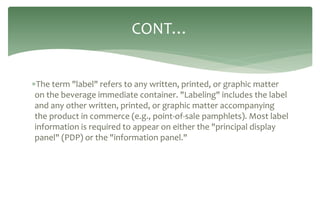Beverage Labelling
- 1. BEVERAGE LABELING NAME AYAZ AHMAD CLASS NO 258 TEACHER Dr. IHSAN MABOOD QAZI SUBJECT BEVERAGE TECHNOLOGY
- 2. ?Food labeling is used to inform consumers of the properties of pre-packaged food. The most important rule of labeling is that the consumer should not be misled. This section covers some of the main areas of food labeling requirements. INTRODUCTION
- 3. ?The term "label" refers to any written, printed, or graphic matter on the beverage immediate container. "Labeling" includes the label and any other written, printed, or graphic matter accompanying the product in commerce (e.g., point-of-sale pamphlets). Most label information is required to appear on either the "principal display panel" (PDP) or the "information panel." CONT…
- 4. ?The PDP is the part of the label most likely to be displayed to, and examined by, consumers under customary conditions of retail sale. The information panel is generally the panel contiguous to, and to the right of, the PDP. If that panel is unusable or too small, the next panel to the right of it may serve as the information panel. If the top of the container is the PDP, the information panel may be any panel adjacent to the PDP. CONT…
- 5. ?Food laws provide that a beverage product may be deemed "misbranded" if any part of its labeling is false or misleading. This general provision establishes misbranding even where no specific regulatory requirement has been violated. A food also may be deemed misbranded if any required information is not presented prominently enough—that is, likely to be read and understood by the ordinary consumer under usual conditions of purchase and use. MISBRANDING
- 6. ?THE GENERAL LABELING REQUIREMENTS ARE THAT BEVERAGE MUST BE LABEL IN ENGLISH.THE BEVERAGE MAY ALSO BE LABELED IN OTHER LANGUAGES BUT ONLY IN ADDITION TO ENGLISH. LANGUAGE OF LABELING
- 7. ?BUSINESS NAME AND ADDRESS OF THE MANUFACTURER OR PACKAGER ? INGREDIENTS ?QUANTITY OF CERTAIN INGREDIENTS ?NET QUANTITY ?DATE OF MINIMUM DURABILITY ?ANY SPECIAL STORAGE INSTRUCTIONS OR CONDITIONS OF USE ? PLACE OF ORIGIN OF THE FOOD STUFF IF ITS ABSENCE MIGHT MISLEAD THE CONSUMER TO A MATERIAL DEGREE ?INSTRUCTION FOR USE IF NECESSARY INFORMATION ON THE LABEL
- 8. NAME OF THE PRODUCT
- 9. ?For any given product, the statement of identity is one of the following ?The name of the beverage as specified in any applicable federal law or regulation, or a federal common or usual name regulation. ?The common or usual name of the beverage, established by common usage ? An appropriately descriptive term ?A fanciful name commonly used by the public when the nature of the beverage is obvious IDENTITY STATEMENT
- 11. ?Each ingredient present in a beverage product must be listed by its common or usual name in descending order of predominance by weight. While most ingredients must be identified by their specific name. Special rules apply to the listing of certain types of ingredients. For example, chemical preservatives must be listed by their name, followed by a description of their function— such as "BHT (a preservative)." Certified color additives must be identified by their specific name (e.g., "Yellow 5" or "FD&C Blue 1 Lake"), but color additives not subject to certification may be listed using a generic term (e.g., "artificial color") or a specific name followed by a description of its function (e.g., "caramel color"). INGREDIENT LIST
- 12. NUTRITION FACTS
- 13. ?The amounts of certain nutrients present in one serving of the beverage product must be presented in the "nutrition facts" panel. Similar products have the same serving size so that consumers can easily compare nutrient levels. Nutrition facts must state the serving size (i.e., the size of one serving) and, unless the product contains only a single serving, the number of servings in the package. Generally, the following nutrients must be declared: calories, total carbohydrate, dietary fiber, sugars, protein, vitamin A, vitamin C, and calcium. If other vitamins or minerals are added to the food, they also must be declared. They must appear on the same panel as the ingredients list and the signature line, unless there are space constraints NUTRITION FACTS
- 14. Any special storage instructions or conditions of use “Chill before serving” STOTAGE INSTRUCTION
- 15. EXPIRATION DATE
- 16. MANUFACTURER
- 17. ?The name and place of business of the manufacturer, packer, or distributor is typically called the "signature line" and must be presented on the same panel as the ingredients list and nutrition facts (usually the information panel), unless space constraints preclude such placement. If the name is not that of the manufacturer, it must be preceded by a qualifying phrase stating the firms relation to the product (e.g., "manufactured for" or "distributed by"). The signature line must include a city or town, state or country, and ZIP code. A street address must be provided unless the firm is listed in a current city or telephone directory. MANUFACTURER

















